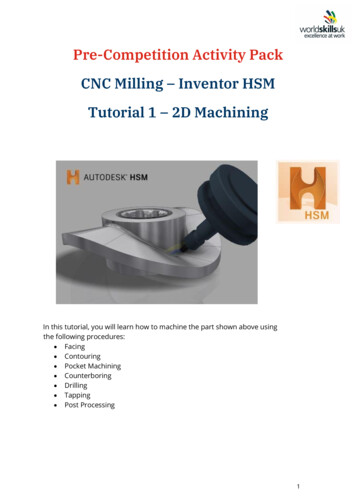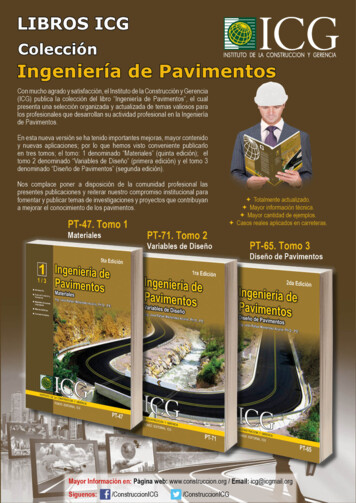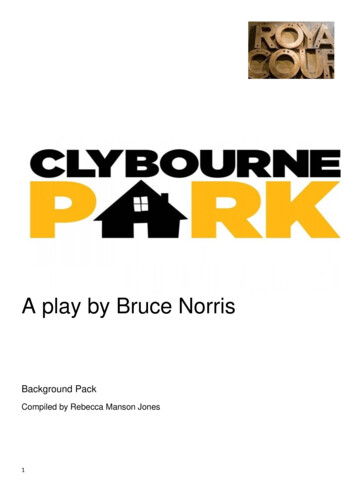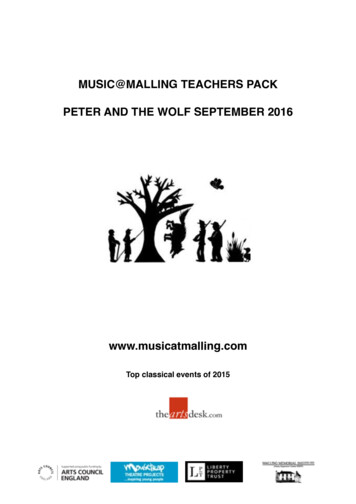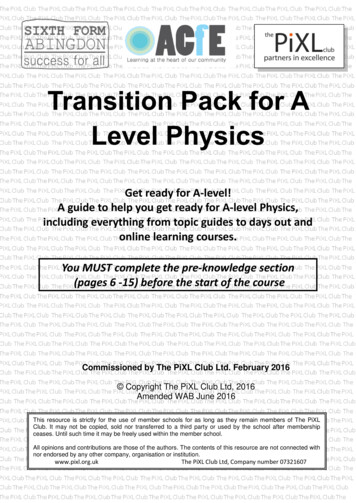
Transcription
Transition Pack for ALevel PhysicsGet ready for A-level!A guide to help you get ready for A-level Physics,including everything from topic guides to days out andonline learning courses.You MUST complete the pre-knowledge section(pages 6 -15) before the start of the courseCommissioned by The PiXL Club Ltd. February 2016 Copyright The PiXL Club Ltd, 2016Amended WAB June 2016This resource is strictly for the use of member schools for as long as they remain members of The PiXLClub. It may not be copied, sold nor transferred to a third party or used by the school after membershipceases. Until such time it may be freely used within the member school.All opinions and contributions are those of the authors. The contents of this resource are not connected withnor endorsed by any other company, organisation or institution.www.pixl.org.uk Copyright The PiXL Club Ltd, 2016The PiXL Club Ltd, Company number 07321607 1
Figure 1 n-physics.gifThis pack contains a programme of activities and resources to prepare you tostart an A level in Physics in September. It is aimed to be used after youcomplete your GCSE, throughout the remainder of the Summer term and overthe Summer Holidays to ensure you are ready to start your course inSeptember.2 Copyright The PiXL Club Ltd, 2016
Book RecommendationsBelow is a selection of books that should appeal to a physicist – someone with an enquiring mind who wantsto understand the universe around us. None of the selections are textbooks full of equation work (there will beplenty of time for that!) instead each provides insight to either an application of physics or a new area of studythat you will be meeting at A Level for the first time.1.Surely You're Joking Mr Feynman: Adventures of a Curious CharacterISBN - 009917331X - Richard Feynman was a Nobel Prize winning Physicist. Inmy opinion he epitomises what a Physicist is. By reading this book you will getinsight into his life’s work including the creation of the first atomic bomb and hisbongo playing adventures and his work in the field of particle physics.(Also available on Audio m/surely youre joking mr feynman adventures of a curious character2.Moondust: In Search of the Men Who Fell to EarthISBN – 1408802384 - One of the greatest scientific achievements of all timewas putting mankind on the surface of the moon. Only 12 men made the tripto the surface, at the time of writing the book only 9 are still with us. Thebook does an excellent job of using the personal accounts of the 9 remainingastronauts and many others involved in the space program at looking at thewhole space-race era, with hopefully a new era of space flight about to beginas we push on to put mankind on Mars in the next couple of erm/moondust in search of the men who fell to earth3.Quantum Theory Cannot Hurt You: Understanding the Mind-Blowing Building Blocks of the UniverseISBN - 057131502X - Any Physics book by Marcus Chown is an excellentinsight into some of the more exotic areas of Physics that require no priorknowledge. In your first year of A-Level study you will meet the quantumworld for the first time. This book will fill you with interesting facts andhandy analogies to whip out to impress your ory-cannot-hurt-you/marcuschown/97805713150243 Copyright The PiXL Club Ltd, 2016
4.A Short History of Nearly EverythingISBN – 0552997048 - A modern classic. Popular science writing at its best. AShort History of Nearly Everything Bill Bryson’s quest to find out everythingthat has happened from the Big Bang to the rise of civilization - how we gotfrom there, being nothing at all, to here, being us. Hopefully by reading it youwill gain an awe-inspiring feeling of how everything in the universe isconnected by some fundamental /a short history of nearly everything5.Thing Explainer: Complicated Stuff in Simple WordsISBN – 1408802384 - This final recommendation is a bit of a wild-card – abook of illustrated cartoon diagrams that should appeal to the scientific sideof everyone. Written by the creator of online comic XTCD (a great source ofscience humour) is a book of blueprints from everyday objects such as a biroto the Saturn V rocket and an atom bomb, each one meticulously explainedBUT only with the most common 1000 words in the English Language. Thiswould be an excellent coffee table book in the home of every xplainer/randall-munroe/9781473620919Movie / Video Clip RecommendationsHopefully you’ll get the opportunity to soak up some of the Sun’s rays over the summer – synthesising someimportant Vitamin-D – but if you do get a few rainy days where you’re stuck indoors here are some ideas forfilms to watch or clips to find online.Science Fictions Films1.2.3.4.5.Moon (2009)Gravity (2013)Interstellar (2014)The Imitation Game (2015)The Prestige (2006)Online Clips / Series1.Minute Physics – Variety of Physics questions explained simply (in felt tip) in a couple of minutes.Addictive viewing that will have you watching clip after clip – a particular favourite of mine is “Why isthe Sky Dark at s2.Wonders of the Universe / Wonders of the Solar System – Both available of Netflix as of 17/4/16 –Brian Cox explains the Cosmos using some excellent analogies and wonderful imagery.4 Copyright The PiXL Club Ltd, 2016
3.Shock and Awe, The Story of Electricity – A 3 part BBC documentary that is essential viewing if youwant to see how our lives have been transformed by the ideas of a few great scientists a little over100 years ago. The link below takes you to a stream of all three parts joined together but it is bestwatched in hourly instalments. Don’t forget to boo when you see Edison. (alternatively watch anyHorizon documentary – loads of choice on Netflix and the I-Player)https://www.youtube.com/watch?v Gtp51eZkwoI4.NASA TV – Online coverage of launches, missions, testing and the ISS. Plenty of clips and links toexplore to find out more about applications of Physics in Space .The Fantastic Mr. Feynman – I recommended the book earlier, I also cannot recommend this 1 hourdocumentary highly enough. See the life’s work of the “great explainer”, a fantastic mind that createdmischief in all areas of modern Physics.https://www.youtube.com/watch?v LyqleIxXTpw5 Copyright The PiXL Club Ltd, 2016
Pre-Knowledge TopicsBelow are ten topics that are essential foundations for you study of A-Level Physics. Each topic has examplequestions and links where you can find our more information as you prepare for next year. You mustanswers all sections- remember this is NOT a test, look up and learn what you don’t know already!Symbols and PrefixesPrefixSymbolPower of tenNanonx 10Microμx 10Millimx 10Centicx 10Kilokx 10MegaMx 10GigaGx 10-9-6-3-2369At A level, unlike GCSE, you need to remember all symbols, units and prefixes. Below is a list of quantities youmay have already come across and will be using during your A level tanceRΩPotential differenceVVCurrentIE or -1kgmsPowerpPDensityρ (rho)kgmChargeQCW-36 Copyright The PiXL Club Ltd, 2016
Solve the following:1.How many metres in 2.4 km?2.How many joules in 8.1 MJ?3.7.Convert 632 nm into m. Express in standardform.8.Convert 1002 mV into V. Express instandard form.9.How many eV in 0.511 MeV? Express instandard form.Convert 326 GW into W.4.Convert 54 600 mm into m.5.How many grams in 240 kg?6.Convert 0.18 nm into m.10. How many m in 11 km? Express in standardform.Standard FormAt A level quantity will be written in standard form, and it is expected that your answers will be too.y3This means answers should be written as .x 10 . E.g. for an answer of 1200kg we would write 1.2 x 10 kg. Formore information visit: Write 2530 in standard form.7.Write 2.4 x 10 as a normal number.2.Write 280 in standard form.8.Write 3.505 x 10 as a normal number.3.Write 0.77 in standard form.9.Write 8.31 x 10 as a normal number.4.Write 0.0091 in standard form.10. Write 6.002 x 10 as a normal number.5.Write 1 872 000 in standard form.11. Write 1.5 x 10 as a normal number.6.Write 12.2 in standard form.12. Write 4.3 x 10 as a normal number.162-437 Copyright The PiXL Club Ltd, 2016
Rearranging formulaeThis is something you will have done at GCSE and it is crucial you master it for success at A level. For a recap ofGCSE watch the following for-avariablewww.youtube.com/watch?v WWgc3ABSj4Rearrange the following:1.E m x g x h to find h2.Q I x t to find I3.E ½ m v to find4.25.v u at to find u6.v u at to find a7.v u 2as to find s8.v u 2as to find u22222E ½ m v to find v8 Copyright The PiXL Club Ltd, 2016
Significant figuresAt A level you will be expected to use an appropriate number of significant figures in your answers. Thenumber of significant figures you should use is the same as the number of significant figures in the data youare given. You can never be more precise than the data you are given so if that is given to 3 significant youranswer should be too. E.g. Distance 8.24m, time 1.23s therefore speed 6.75m/sThe website below summarises the rules and how to round ng2.htmGive the following to 3 significant figures:1. 3.4527 (3sf)4. 1.0247 2. 40.691 5. 59.972 3. 0.838991 Calculate the following to a suitable number of significant figures:6. 63.2/78.1 ( sf)7. 39 78 120 ( sf)8. (3.4 3.7 3.2)/3 ( sf)9. 0.0256 x 0.129 ( sf)10. 592.3/0.1772 ( sf)9 Copyright The PiXL Club Ltd, 2016
Atomic StructureYou will study nuclear decay in more detail at A level covering the topics of radioactivity and particle physics. Inorder to explain what happens you need to have a good understanding of the model of the atom. You need toknow what the atom is made up of, relative charges and masses and how sub atomic particles are arranged.The following video explains how the current model was discoveredwww.youtube.com/watch?v wzALbzTdnc8Describe the model used for the structure of an atom including details of the individual particles that make upan atom and the relative charges and masses of these particles. You may wish to include a diagram and explainhow this model was discovered by Rutherford10 Copyright The PiXL Club Ltd, 2016
Recording DataWhilst carrying out a practical activity you need to write all your raw results into a table. Don’t wait until theend, discard anomalies and then write it up in neat.Tables should have column heading and units in this format quantity/unit e.g. length /mmAll results in a column should have the same precision and if you have repeated the experiment you shouldcalculate a mean to the same precision as the data.Below are link to practical handbooks so you can familiarise yourself with ractical-skills-handbook.pdfBelow is a table of results from an experiment where a ball was rolled down a ramp of different lengths. Aruler and stop clock were used.1) Identify the errors the student has made.TimeLength/cmTrial 1Trial 2Trial 8.249.688.248.72709.019.029.09.01Graphs11 Copyright The PiXL Club Ltd, 2016
After a practical activity the next step is to draw a graph that will be useful to you. Drawing a graph is a skillyou should be familiar with already but you need to be extremely vigilant at A level. Before you draw yourgraph to need to identify a suitable scale to draw taking the following into consideration: the maximum and minimum values of each variable whether 0.0 should be included as a data point; graphs don’t need to show the origin, a false origin can beused if your data doesn’t start near zero. the plots should cover at least half of the grid supplied for the graph. the axes should use a sensible scale e.g. multiples of 1,2, 5 etc)Identify how the following graphs could be improvedGraph 1Graph 2807060Voltage504030201000102030Time/s12 Copyright The PiXL Club Ltd, 2016
Forces and MotionAt GCSE you studied forces and motion and at A level you will explore this topic in more detail so it is essentialyou have a good understanding of the content covered at GCSE. You will be expected to describe, explain andcarry calculations concerning the motion of objects. The websites below cover Newton’s laws of motion andhave links to these in active/Sketch a velocity-time graph showing the journey of a skydiver after leaving the plane to reaching the ground.Mark on terminal velocity.13 Copyright The PiXL Club Ltd, 2016
ElectricityAt A level you will learn more about how current and voltage behave in different circuits containing differentcomponents. You should be familiar with current and voltage rules in a series and parallel circuit as well ascalculating the resistance of a hysicsclassroom.com/class/circuits1a) Add the missing ammeter readings on the circuits below.b) Explain why the second circuit has more current flowing than the first.2) Add the missing potential differences to the following circuits14 Copyright The PiXL Club Ltd, 2016
WavesYou have studied different types of waves and used the wave equation to calculate speed, frequency andwavelength. You will also have studied reflection and refraction.Use the following links to review this ntroduction-to-waves1) Draw a diagram showing the refraction of a wave through a rectangular glass block. Explain why the ray oflight takes this path.2) Describe the difference between a longitudinal and transverse waves and give an example of each3) Draw a wave and label the wavelength and amplitude15 Copyright The PiXL Club Ltd, 2016
Ideas for Day TripsHere are some suggestions for some physics-themed days out for you to enjoy over the summer break. Try andhave some fun as you prepare for two tough but rewarding years ahead!Northern England and Scotland1.2.3.4.5.Jodrell Bank Observatory – Cheshire – one of the largest moveable radio telescopes in the world and thelocation of the filming of the BBC’s Stargazing Live. The site has both indoor and outdoor activities.MOSI – Manchester – Massive free museum showing how science helped Britain lead the way through theindustrial revolution. Contains hands on exhibits and displays and often host regular travelling exhibitions.Liverpool World Museum / Spaceport – Liverpool/Wirral – Start the day off at an excellent family sciencemuseum with a top floor dedicated to astronomy including a planetarium. Take the ferry cross the Merseyto another family friendly museum dedicated to spaceflight.Kielder Observatory – Northumberland – Book ahead at this popular observatory in the midst of thedarkest night skies the UK has to offer. Regular tours and opportunities to view the stars throughprofessional telescopes take place on a nightly basis.Glasgow Science Centre - The Centre is home to hundreds of interactive exhibits throughout the threeengaging floorsThe Midlands and Wales1.2.3.Electric Mountain – Snowdonia – Set against a mountainous backdrop is a working pumped storagepower station. Take a tour deep into the heart of the mountain and see the turbines spring into action tomeet our ever increasing demand for electricity. Take a stroll up on of the UKs highest peaks in theafternoon.National Space Centre – Leicester - With six interactive galleries, the UK’s largest planetarium, unique 3DSimulator experience, the award-winning National Space Centre in Leicester is an out of this world visitorattractionAlton Towers – Staffordshire – Treat yourself to a go on a few rollercoasters whilst discussing Newton’sLaws. You may want to download and take these handy rollercoaster physics notes with htmlSouthern England1.2.3.4.Royal Observatory – London - Visit the Royal Observatory Greenwich to stand on the historic PrimeMeridian of the World, see the home of Greenwich Mean Time (GMT), and explore your place in theuniverse at London’s only planetarium.Herschel Museum of Astronomy – Bath – As you walk around the picturesque Roman city – take an houror two out at the home of one of the great scientists – discoverer of Infra-red radiation and Uranus.@Bristol – Bristol - home to the UK’s only 3D Planetarium and one of the biggest science centres.The Royal Institution – London – The birthplace of many important ideas of modern physics, includingMichael Faraday’s lectures on electricity. Now home to the RI Christmas lectures and many exhibits ofscience history.16 Copyright The PiXL Club Ltd, 2016
4. A Short History of Nearly Everything ISBN – 0552997048 - A modern classic. Popular science writing at its best. A Short History of Nearly Everything Bill Bryson’s quest to find out everything that has happened from the Big Bang to the rise of civilization - how we






